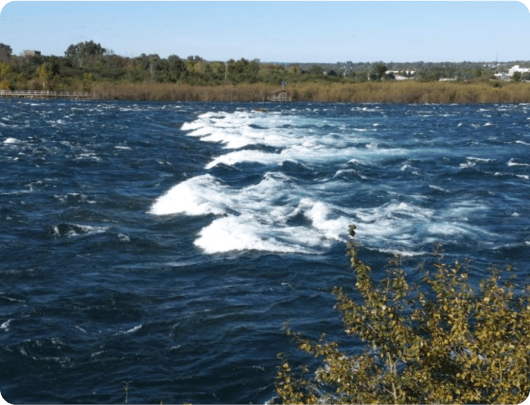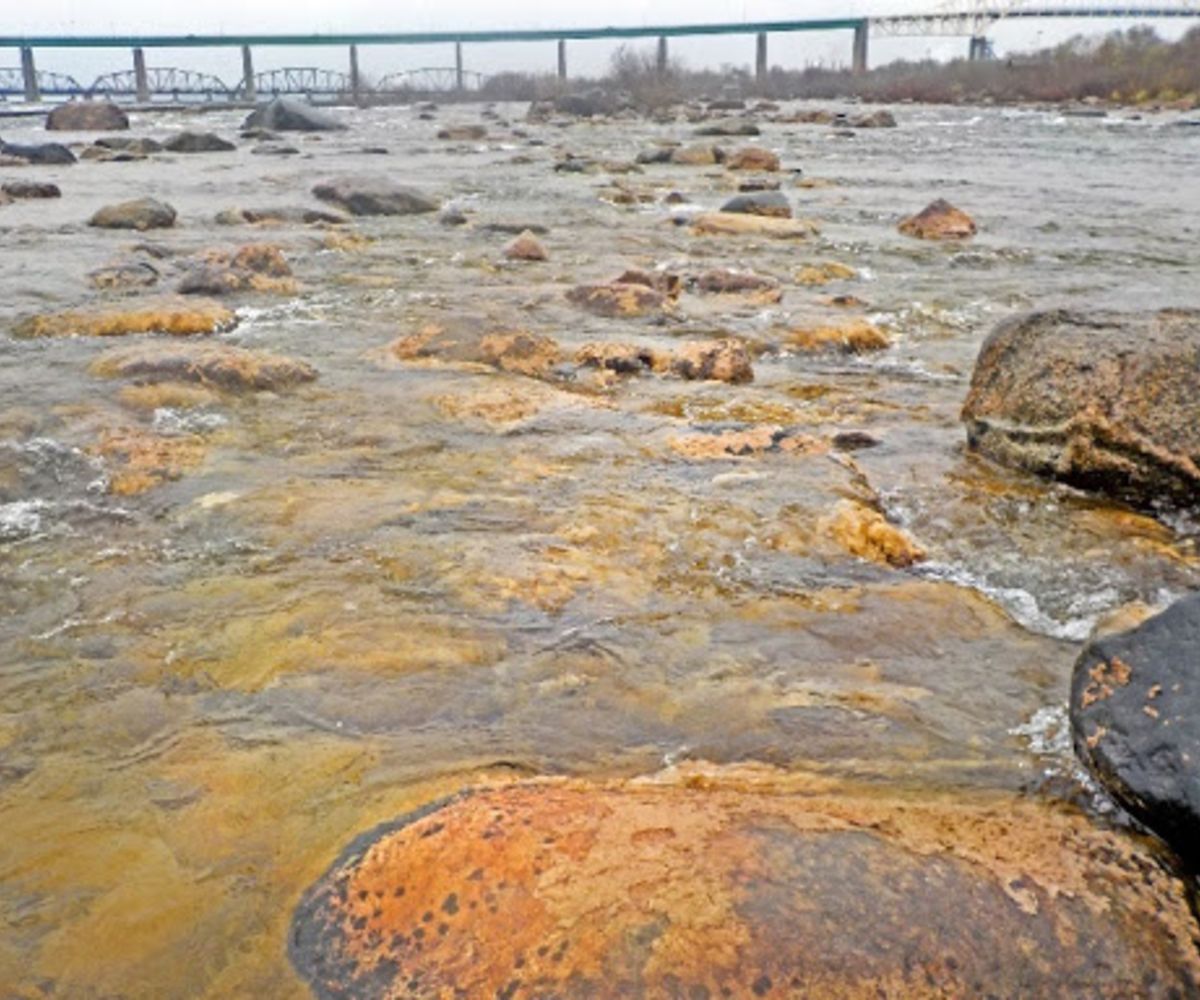Nominate a Professor for the Distinguished Teaching Award! Click here
Keep up with important dates this semester here
Curious about the construction on Meridian Street? Click to learn more
The Center for Freshwater Research and Education houses a highly-equipped water quality laboratory and offers lab services to meet your analyzing needs. Explore our CFRE Instrumentation page to see what we can provide.
Visit our Analytical Services page to review our method summaries and to submit a request for analysis please visit the Analysis Request page.
The instruments below are housed at the Center for Freshwater Research and Education (CFRE) and are available to meet your analyzing needs. Explore the instruments below to see what they can provide.
The AQ300 discrete analyzer is used to run analysis for nutrients like total nitrogen and phosphorus, soluble reactive phosphorus (SRP), nitrates, ammonia, silica, etc. The analyzer uses a robotic arm to dispense exact volumes and mix samples and reagents. Each sample is read through an optical glass cuvette, giving lower detection limits and better reproducibility.
The Integrion IC uses an eluent to analyze water samples for anion and cation concentrations. Anions include: fluoride, chloride, bromide, sulfate, phosphate, nitrate, nitrite. Cations include: lithium, sodium, ammonium, potassium, magnesium, calcium.
The Genesys 180 UV-Vis Spectrophotometer performs high throughput quantitative UV-Vis measurements where a double beam is required as a reference cell position. This instrument is primarily used for chlorophyll a analysis.
The QIAamplifier 96 is an end-point thermal cycler. It is designed to amplify nucleic acids by repeated cycles of heating and cooling using DNA polymerases in a polymerase chain reaction (PCR).
The QIAcuity Digital PCR System is designed to deliver precise and multiplexed quantification results for mutation detection, copy number variation (CNV), gene expression studies, gene-editing analysis, and many more.
The IDEXX Quanti-Tray Sealer PLUS is used to seal Quanti-Trays to quantify bacterial testing results for total coliforms and E. coli.
Listed below are analyses available by instrument. If you do not see a service you are looking for, please reach out to inquire about additional services we may provide. Our capabilities for each instrument is expanding and we may be able to accommodate your request.
| SERVICE | INSTRUMENT | METHOD REFERENCE |
| Total Nitrogen | AQ300 Discrete Analyzer | EPA-127-D |
| Ammonia-N | AQ300 Discrete Analyzer | EPA-148-D |
| Nitrate+Nitrite | AQ300 Discrete Analyzer | EPA-127-D |
| Soluble Reactive Phosphate (SRP) | AQ300 Discrete Analyzer | EPA-155-D |
| Total Phosphorus | AQ300 Discrete Analyzer | EPA-365.1 |
| Silica | AQ300 Discrete Analyzer | EPA-121-D |
| Calcium | AQ300 Discrete Analyzer | UKAS-590-A |
| Color | AQ300 Discrete Analyzer | EPA-147-A |
| Chloride | AQ300 Discrete Analyzer | EPA-105-D |
| Sulfate | AQ300 Discrete Analyzer | EPA-165-D |
| Cations (Li, Na, NH4, K, Mg, Ca) | Thermo Scientific Dionex Integrion Ion Chromatography | EPA 300.0 |
| Anions (Fl, Cl,Br,SO4,PO4,NO3,NO2) | Thermo Scientific Dionex Integrion Ion Chromatography | EPA 300.0 |
| Total Coliforms & Escherichia Coli | IDEXX Quanti-Tray Sealer PLUS | Colilert-18, Modified Colitag, EPA 1604 |
| dPCR analysis | QIAGEN QIAcuity One Digital Polymerase Chain Reaction (dPCR) Instrument | |
| Chlorophyll-a | Genesys 180 UV-Visible Spectrophotometer (Thermo Scientific) | SM 10200 H |
Ammonia-N is analyzed using the SEAL AQ300 Discrete analyzer. Ammonia in the sample reacts with hypochlorite (HClO-) at an alkaline pH. The chloramine formed then reacts with salicylate, at pH at least 12.6, in presence of nitroferricyanide. During a static incubation of 40C, a blue-green indophenol dye forms, which is measured photometrically at 660nm.
References:
SEAL Analytical, AQ300 Method EPA-148-D Rev. 2
Methods for the Determination of Inorganic Substances in Environmental Samples, EPA 600/R 93/100, August 1993: Method 350.1, Revision 2.0
Calcium is analyzed using the SEAL AQ300 Discrete analyzer. ARSENAZO III specifically binds to calcium forming a blue-colored complex that can be
measured at 660/670 nm
References:
SEAL Analytical, AQ2 Method NO: UKAS-590-A
Tietz, NW., Fundamentals of Clinical Chemistry, 2nd Ed. (1976)
US Environmental Protection Agency, 40 CFR, Part 136, Appendix B
Chloride is analyzed using the SEAL AQ300 Discrete analyzer. The thiocyanate ion (SCN-) is liberated from mercuric thiocyanate through sequestration of mercury by the chloride ion to form non-ionized mercuric chloride. In the presence of ferric ions, the liberated thiocyanate ions form a highly-colored ferric thiocyanate. The absorbance of this complex is measured spectrophotometrically at 480nm.
References:
SEAL Analytical, AQ300 Method EPA-105-D Rev. A
Methods for Chemical Analysis of Waters and Wastes, US EPA 600/4-79-020, 1983: Method 325.2
Standards Methods for the Examination of Water and Wastewater, APHA/AWWA/WEF, method 4500-Cl-E (18th, 19th, 20th Ed.).
Color is analyzed using the SEAL AQ300 Discrete analyzer. Color is determined by comparison of the sample with known concentrations of platinum-cobalt standards. One unit of color is that produced by 1.0 mg/L platinum in the form of chloroplatinate ion. The absorbance of the solution is measured spectrophotometrically at 450 nm.
References:
SEAL Analytical, AQ2 Method EPA-147-A Rev. 0
Standard Methods for the Examination of Water and Wastewater, method 2120 B (18th, 19th, 20th ed.).
Standard Methods for the Examination of Water and Wastewater, method 2120 C (21th ed.).
U.S. Environmental Protection Agency, 40 CFR, Part 136, Appendix B and 136.3 Tables IB and II, and Part 143.
2003 NELAC Standard, National Environmental Laboratory Accreditation Conference, June 5, 2003, EPA-600/R-04/003, http://www.epa.gov/nerlesd1/land-sci/nelac/index.html
Manual for the Certification of Laboratories Analyzing Drinking Water, 4th ed., USEPA 815/B-97/001, March 1997.
Nitrate-N + Nitrite-N is analyzed using the SEAL AQ300 Discrete analyzer. The sample is mixed with pH buffer and then travels through a copperized cadmium coil, where nitrate is chemically reduced to nitrite. The chemically-reduced sample is mixed with color reagent, prepared in dilute phosphoric acid. The nitrite from chemical reduction and the original nitrite react with sulfanilamide to form a diazonium compound. This species couples with N-(1-naphthyl)-ethylenediamine dihydrochloride to form a reddish-purple azo dye that is measured photometrically at 520nm.
References:
SEAL Analytical, AQ300 Method EPA-127-D Rev. A
Methods for Determination of Inorganic Substances in Environmental Samples, USEPA 600/R 93/100, August 1993: Method 353.2, Revision 2.0
Standard Methods for the Examination of Water and Wastewater, APHA/AWWA/WEF, method 4500-NO3–F (2000)
Silica is analyzed using the SEAL AQ300 Discrete analyzer. Under acidic conditions molybdate-reactive silica combines with ammonium molybdate to form a yellow molybdo-silicic acid complex. This complex is chemically reduced by adding buffered 4-amino-3-hydroxy-1-naphthalenesulfonic acid to form a silico-molybdenum blue complex. The absorbance of the final product is measured spectrophotometrically at 660nm.
References:
SEAL Analytical, AQ300 Method EPA-121-D Rev. A
Methods for Chemical Analysis of Waters and Wastes, US EPA 600/4-79-020, 1983: Method 370.1
Standards Methods for the Examination of Water and Wastewater, APHA/AWWA/WEF, method 4500 SiO2 –C (20th Ed), and 4500 – SiO2 (18th, 19th Ed).
Soluble Reactive phosphate is analyzed using the SEAL AQ300 Discrete analyzer. Reaction with acidic molybdate in the presence of antimony forms an antimony phospho-molybdate complex. This complex is chemically reduced by ascorbic acid to an intensely blue complex: phosphomolybdenum blue. The absorbance of this complex is measured photometrically at 880nm.
References:
SEAL Analytical, AQ300 Method EPA-155-D Rev. 0
Methods for the Determination of Inorganic Substances in Environmental Samples, USEPA 600/R 93/100, August 1993: Method 365.1, Rev. 2.0.
Standard Methods for the Examination of Water and Wastewater, APHA/AWWA/WEF, method 4500-P-F (1999 forward).
Sulfate is analyzed using the SEAL AQ300 Discrete analyzer. Sulfate ion is converted to a barium suspension under controlled conditions. The resulting turbidity is determined using a filter photometer at 405 nm.
References:
SEAL Analytical, AQ300 Method EPA-165-D Rev. A
ASTM D516-11, Standard Test Methods for Sulfate Ion in Water, ASTM International, West Conshohocken, PA, 2011, www.astm.org.
Standard Methods for the Examination of Water and Wastewater, APHA/AWWA/WEF, 4500-SO42- E (1997 forward).
ISO/DIS 15923-1, Water Quality – Determination of selected parameters by a discrete analysis system – Part 1: Ammonium, nitrate, nitrite, chloride, orthophosphate, sulfate and silicate with photometric detection.
Total nitrogen converts organic and inorganic nitrogen to Nirate + Nitrite compounds by a high pressure digest. A potassium persulfate digestion is used to oxidize organic N and ammonia into nitrate. After digestions, Total nitrogen is analyzed using the Nitrate-N + Nitrite-N AQ300 discrete analyzer method.
References:
Ameel, J.J., R.P. Axler, C.J. Owen. 1993. Persulfate digestion for determination of total nitrogen and phosphorus in low nutrient water. American Environmental Laboratory. 5: 2-11.
SEAL Analytical, AQ300 Method EPA-127-D Rev. A
Total phosphorus converts organic and inorganic phosphorus to soluble phosphorus compounds using a potassium persulfate digestion. After digestions, Total phosphorus is analyzed using the p-Phosphate-P AQ300 discrete analyzer method.
References:
Ameel, J.J., R.P. Axler, C.J. Owen. 1993. Persulfate digestion for determination of total nitrogen and phosphorus in low nutrient water. American Environmental Laboratory. 5: 2-11.
Methods for the Determination of Inorganic Substances in Environmental Samples, USEPA 600/R 93/100, August 1993: Method 365.1, Rev. 2.0.
Standard Methods for the Examination of Water and Wastewater, APHA/AWWA/WEF, method 4500-P-F (1999 forward).
If you are interested in having samples analyzed at the CFRE Water Quality Lab, please follow the instructions below.
Sample filtering must be done prior to submission, if filtering is necessary. At this time, CFRE’s Water Quality Lab does not offer sample preparation or filtering services. The user is responsible for ensuring that samples are collected, preserved, and stored appropriately.
Prepare your samples by sealing them in a plastic Ziploc bag, placing them on ice, and overnighting them to the address below:
ATTN: Shawnee McMillian
100 Salmon Run Way
Sault Ste. Marie, MI 49783
Contact our Laboratory Technician for more information about our
Lab Services.
Research Scientist




